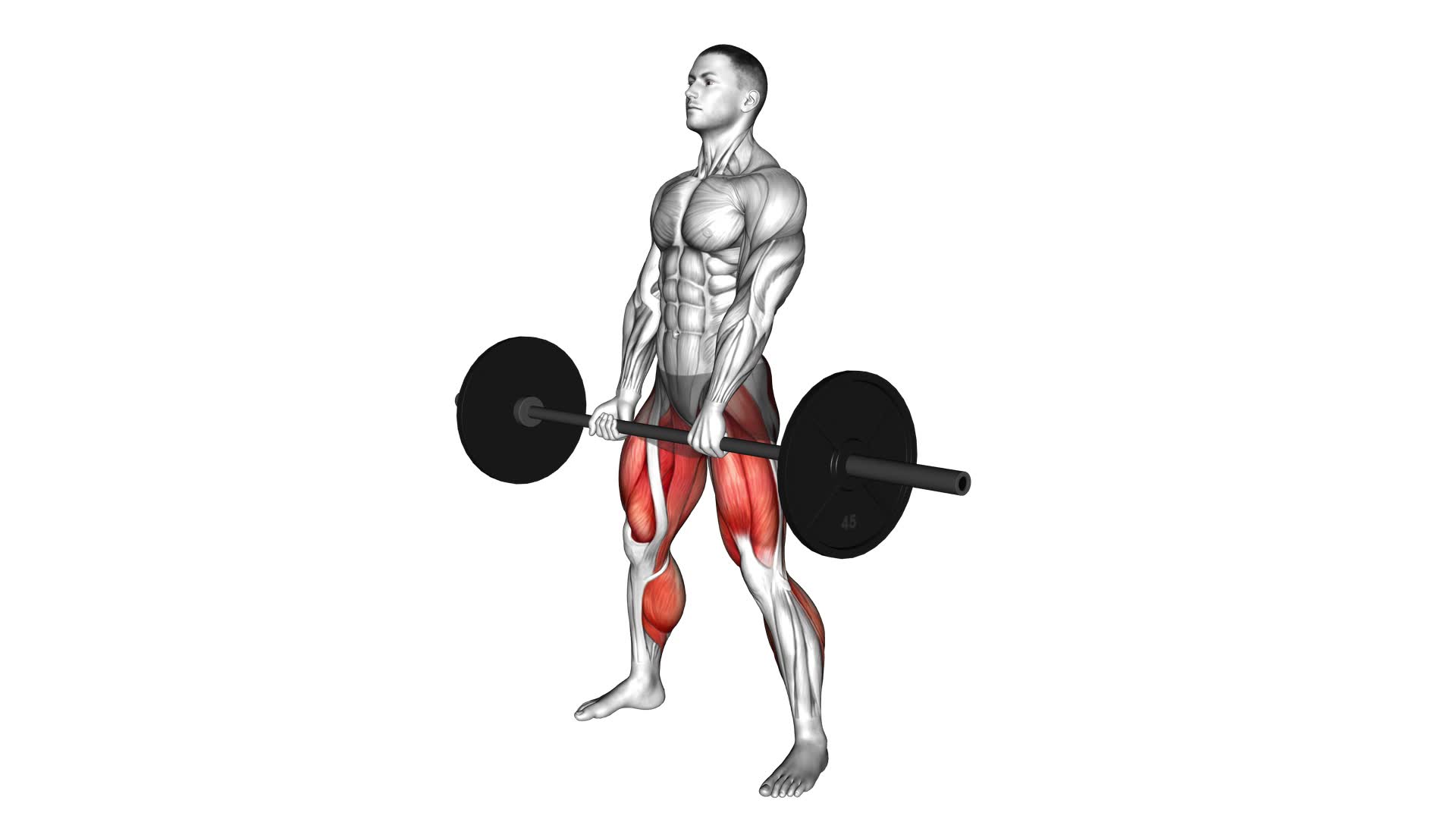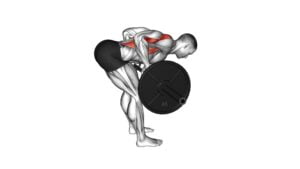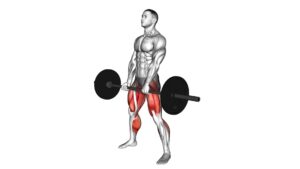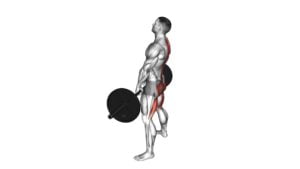Barbell Paused Sumo Deadlift – Video Exercise Guide & Tips

Are you looking for an effective way to strengthen your lower body and improve your lifting technique? Look no further than the barbell paused sumo deadlift.
Watch This Exercise Video
This exercise targets your glutes, hamstrings, quads, and core, helping you build strength and power.
In this video exercise guide, you'll learn the proper form and technique, common mistakes to avoid, variations and progressions, and tips to maximize your results.
Get ready to take your deadlifts to the next level with this challenging yet rewarding exercise.
Key Takeaways
- Targets glutes, hamstrings, quads, and core
- Increases muscle activation
- Improves stability and balance
- Enhances grip strength
Benefits of Barbell Paused Sumo Deadlifts
You can experience several benefits by incorporating barbell paused sumo deadlifts into your workout routine. One of the main benefits is increased muscle activation. When performing this exercise, you engage multiple muscle groups, including your quadriceps, hamstrings, glutes, and lower back. The sumo stance used in this variation of the deadlift puts more emphasis on the lower body muscles, making it a great exercise for targeting those areas.
By pausing at the bottom of the movement, you add an additional challenge to the exercise. This pause requires you to maintain tension in your muscles, leading to increased muscle activation and strength gains. It also helps to improve your overall stability and balance.
Incorporating barbell paused sumo deadlifts into your routine can also help with improving your grip strength. As you lift heavier weights, your grip strength plays a crucial role in maintaining control of the barbell. By consistently performing this exercise, you can strengthen your grip and enhance your performance in other exercises that require a strong grip.
Now that you understand the benefits of barbell paused sumo deadlifts, let's move on to discussing the proper form and technique for performing this exercise.
Proper Form and Technique
To perform the Barbell Paused Sumo Deadlift with proper form and technique, there are a few key points to keep in mind.
First, ensure your foot placement is wide, with your toes pointed outwards to engage the muscles of the inner thighs.
Second, focus on engaging your core throughout the movement to maintain stability and protect your lower back.
Foot Placement Tips
Achieving proper form and technique for the barbell paused sumo deadlift requires careful attention to your foot placement. Here are some foot placement tips to help you maximize your performance and prevent injury:
- Foot stance: Start by positioning your feet wider than shoulder-width apart, with your toes pointed out at a slight angle. This wide stance allows for a greater range of motion and increases the activation of your glutes and hamstrings.
- Weight distribution: Ensure that your weight is evenly distributed between both feet. This will help you maintain balance and stability throughout the lift. Avoid shifting all the weight onto your toes or heels, as this can lead to imbalance and potential injuries.
- Ground contact: Keep your entire foot in contact with the ground throughout the lift. This provides a solid base of support and allows you to generate maximum power from the ground up.
- Toe angle: Experiment with different toe angles to find the position that feels most comfortable and natural for you. Adjusting the toe angle can help optimize your hip and knee alignment, allowing for a more efficient lift.
By focusing on proper foot placement, you can set a solid foundation for a successful barbell paused sumo deadlift.
Now, let's transition into the next section about engaging the core.
Engaging the Core
To engage your core properly during the barbell paused sumo deadlift, focus on maintaining a strong and stable midsection throughout the exercise. This will help you maintain proper alignment and prevent unnecessary strain on your lower back.
To enhance core stability, you can incorporate variations of the barbell paused sumo deadlift, such as using resistance bands or performing the exercise on an unstable surface. Additionally, incorporating core stability exercises into your training routine, such as planks and Russian twists, can further strengthen your core muscles and improve your overall stability during the movement. Engaging your core during the barbell paused sumo deadlift is essential for maintaining proper form and preventing injuries.
Now, let's move on to discuss the importance of hip hinge mechanics in this exercise.
Hip Hinge Mechanics
Use a proper hip hinge technique to ensure optimal form and effectiveness during the barbell paused sumo deadlift. The hip hinge is a fundamental movement pattern that involves bending at the hips while keeping a neutral spine. It's crucial for not only the barbell paused sumo deadlift but also for many other exercises that require hip mobility and stability.
Here are four reasons why mastering hip hinge mechanics is essential:
- Efficient force production: A proper hip hinge allows you to generate maximum power from your hips, leading to stronger lifts and improved athletic performance.
- Injury prevention: By maintaining a neutral spine and distributing the load evenly through your hips, you reduce the risk of lower back injuries during exercises like the barbell paused sumo deadlift.
- Enhanced hip mobility: Regularly practicing hip hinge exercises can help improve hip mobility, allowing for a fuller range of motion and better performance in various activities.
- Improved posture and alignment: When you have a strong hip hinge, you develop better posture and alignment, both during exercises and in everyday life.
Mastering the hip hinge mechanics through targeted exercises and focusing on hip mobility is essential for maximizing your performance and reducing the risk of injury during the barbell paused sumo deadlift and other exercises.
Common Mistakes to Avoid
To ensure proper form during the barbell paused sumo deadlift, there are a few key essentials to keep in mind.
Avoid common mistakes such as rounding your back or lifting with your arms instead of your legs.
Correcting these errors will help you maximize the effectiveness of this exercise and reduce the risk of injury.
Proper Form Essentials
Avoiding common mistakes is essential for maintaining proper form in the barbell paused sumo deadlift. To ensure you perform this exercise correctly, here are some essential form tips:
- Proper Breathing Techniques: Before initiating the lift, take a deep breath and brace your core. This will provide stability and support throughout the movement. Exhale at the top of the lift and inhale as you lower the barbell back down.
- Grip Strength Improvement: A strong grip is crucial for a successful deadlift. To improve your grip strength, consider incorporating exercises such as farmer's walks, wrist curls, and plate pinches into your training routine.
- Maintain a Wide Stance: Position your feet wider than shoulder-width apart, with your toes slightly turned out. This will allow for optimal engagement of the glutes, hamstrings, and adductors during the lift.
- Keep a Neutral Spine: Avoid rounding or arching your back during the movement. Maintain a neutral spine by engaging your core and keeping your chest up.
Correcting Common Errors
Common mistakes in the barbell paused sumo deadlift can hinder your performance and increase the risk of injury. One common mistake is rounding your back during the lift, which puts excessive stress on your spine. To avoid this, focus on maintaining a neutral spine throughout the movement.
Another mistake isn't engaging your glutes and hamstrings properly, which can limit the effectiveness of the exercise. Make sure to push your hips forward and squeeze your glutes at the top of the lift.
Lastly, using too much weight can compromise your form and increase the risk of injury. Start with a lighter weight and gradually increase as you perfect your technique.
By avoiding these common mistakes and practicing proper technique, you can maximize the benefits of the barbell paused sumo deadlift.
Now, let's move on to discussing variations and progressions.
Variations and Progressions
As you progress with the barbell paused sumo deadlift, you can incorporate variations to challenge your muscles in different ways. Here are some deadlift variations and sumo deadlift progressions that you can try:
- Deficit Sumo Deadlift: Stand on a raised platform or use weight plates under your feet to increase the range of motion and target your muscles more effectively.
- Romanian Sumo Deadlift: Perform the sumo deadlift with a slower eccentric phase, focusing on the hip hinge movement and keeping tension on your glutes and hamstrings.
- Sumo Deadlift with Chains or Bands: Add chains or resistance bands to the barbell to increase the difficulty throughout the movement, forcing your muscles to work harder as you lift.
- Single-Leg Sumo Deadlift: Challenge your balance and stability by performing the sumo deadlift on one leg at a time. This variation also helps to correct any muscle imbalances.
By incorporating these variations and progressions into your training routine, you can continue to challenge your muscles and make continuous progress.
Now, let's move on to the next section to learn some tips to maximize your results.
Tips to Maximize Results
To optimize your results, focus on implementing key strategies that will enhance the effectiveness of your barbell paused sumo deadlift. By following these tips, you can maximize gains and improve your performance.
First, ensure proper form and technique. Maintain a wide stance, with toes pointing outward and hands gripping the barbell just outside your legs. Keep your back straight, engage your core, and push through your heels as you lift the weight.
Second, incorporate pauses during the lift. This will increase time under tension and challenge your muscles even more. Pause for a few seconds at the bottom of the movement, just above the floor, before explosively lifting the weight back up.
Third, progressively overload your lifts. Gradually increase the weight you lift over time to continually challenge your muscles and stimulate growth. This will help you to continuously make progress and maximize gains.
Lastly, prioritize recovery and rest. Give your body enough time to recover between workouts to prevent overtraining and injury. Get enough sleep, eat a nutritious diet, and listen to your body's signals to ensure optimal performance.
Sample Workout Routine
To maximize your results with the barbell paused sumo deadlift, incorporate a sample workout routine that includes a variety of exercises to target different muscle groups. This will help you build overall strength and improve your deadlift performance.
Here's a sample workout routine that you can follow:
- Barbell Paused Sumo Deadlift: Start with a warm-up set and then perform 3 sets of 6-8 reps with a challenging weight. Pause for 2-3 seconds at the bottom of each rep to increase time under tension and engage your muscles more effectively.
- Romanian Deadlift: This exercise targets your hamstrings and lower back. Perform 3 sets of 10-12 reps with a moderate weight, focusing on maintaining proper form and keeping your back straight throughout the movement.
- Goblet Squat: This exercise targets your quads, glutes, and core. Hold a dumbbell or kettlebell in front of your chest and perform 3 sets of 12-15 reps. Focus on squatting low and keeping your knees in line with your toes.
- Hip Thrust: This exercise targets your glutes and hamstrings. Perform 3 sets of 10-12 reps with a challenging weight. Make sure to squeeze your glutes at the top of each rep for maximum activation.
Remember to listen to your body and make any necessary workout modifications to accommodate your fitness level and goals. Additionally, prioritize recovery strategies such as proper nutrition, hydration, and rest to optimize your performance and prevent injuries.
Frequently Asked Questions
How Does the Barbell Paused Sumo Deadlift Differ From a Regular Sumo Deadlift?
The barbell paused sumo deadlift differs from a regular sumo deadlift by incorporating a pause at the midpoint of the lift. This pause helps to develop strength and stability in the bottom position, as well as improve overall technique.
Can the Barbell Paused Sumo Deadlift Help Improve Grip Strength?
The barbell paused sumo deadlift is a variation of the regular sumo deadlift that involves pausing at the bottom of the lift.
This exercise can be beneficial for improving grip strength. By holding the barbell in place during the pause, you're forcing your grip to work harder.
Additionally, there are different variations of paused sumo deadlifts that can further target and challenge your grip strength.
Should Beginners Attempt the Barbell Paused Sumo Deadlift, or Is It More Suitable for Advanced Lifters?
Beginners can benefit from incorporating the barbell paused sumo deadlift into their strength training program. This exercise helps improve grip strength and targets the muscles in the lower body, including the glutes, hamstrings, and quadriceps.
While it may be more challenging for beginners, with proper form and technique, they can safely attempt this exercise. Advanced lifters can also benefit from the added challenge and variation it provides.
Are There Any Specific Muscles That the Barbell Paused Sumo Deadlift Targets?
The barbell paused sumo deadlift targets specific muscles in your body. It's a great exercise for building strength and muscle in your glutes, hamstrings, and quadriceps.
By pausing at the bottom of the lift, you engage these muscles even more, making the exercise more challenging and effective.
The benefits of this exercise include improved lower body strength, increased muscle mass, and enhanced overall athletic performance.
Can the Barbell Paused Sumo Deadlift Be Incorporated Into a Full-Body Workout Routine, or Is It Better Suited for Lower Body Training Only?
Incorporating the barbell paused sumo deadlift into your full-body workout routine can have numerous benefits for overall strength.
This exercise not only targets your lower body muscles, but also engages your core and upper body.
By pausing at the bottom of the lift, you increase time under tension and enhance muscle activation.
Plus, the sumo stance recruits different muscle groups compared to traditional deadlifts, providing variety to your training and promoting balanced muscle development.
Conclusion
Incorporating barbell paused sumo deadlifts into your workout routine can provide numerous benefits, including increased strength and stability in your lower body. By focusing on proper form and technique, you can avoid common mistakes and maximize your results.
Additionally, incorporating variations and progressions into your workouts can keep your routine challenging and prevent plateaus. Follow the tips provided and consider incorporating barbell paused sumo deadlifts into your next workout for optimal results.

Author
Years ago, the spark of my life’s passion ignited in my mind the moment I stepped into the local gym for the first time. The inaugural bead of perspiration, the initial endeavor, the very first surge of endorphins, and a sense of pride that washed over me post-workout marked the beginning of my deep-seated interest in strength sports, fitness, and sports nutrition. This very curiosity blossomed rapidly into a profound fascination, propelling me to earn a Master’s degree in Physical Education from the Academy of Physical Education in Krakow, followed by a Sports Manager diploma from the Jagiellonian University. My journey of growth led me to gain more specialized qualifications, such as being a certified personal trainer with a focus on sports dietetics, a lifeguard, and an instructor for wellness and corrective gymnastics. Theoretical knowledge paired seamlessly with practical experience, reinforcing my belief that the transformation of individuals under my guidance was also a reflection of my personal growth. This belief holds true even today. Each day, I strive to push the boundaries and explore new realms. These realms gently elevate me to greater heights. The unique combination of passion for my field and the continuous quest for growth fuels my drive to break new ground.







